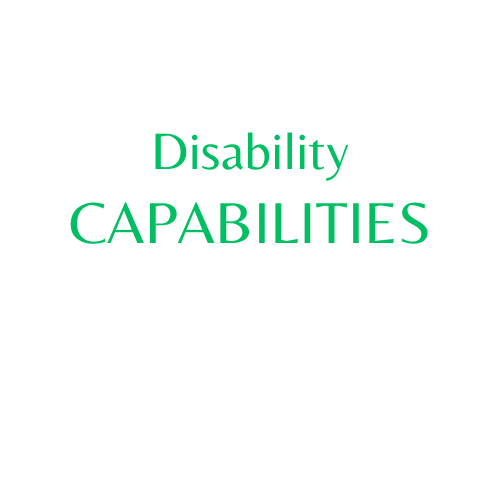Artificial Intelligence, Participation & Disability/Neurodivergence: An Exploratory Study (Part 1)

· Key Takeaways: AI replaces the old industrial system which centralizes and standardizes production and uses a command and control model.
· AI creates combines production with imagination, decentralizes production, and creates conditions for perpetual innovation. This leads to mass personalization which will inevitably enhance inclusion for disabled and neurodivergent persons.
· However, there is a risk that AI's distribution will be centralized, thereby leading to exclusion. It is therefore imperative for disability and neurodivergence advocates to demand an inclusive educational system, deeper diffusion of AI technologies, as well as property and contract laws that will ensure efficient participation and eliminate discapability (the artificial underutilization of the competencies of disabled and neurodivergent persons).
Introduction
The most logical approach to understanding the impact of Artificial Intelligence on society is to analyze what it is doing to the Knowledge Economy, which AI is predicted to replace. The Institute of Public Policy Research, located in the United Kingdom identified that up to 70% of the white-collar jobs (most of which are executed through the knowledge economy in the office and intellectual environment) will be replaced or transformed greatly by Generative Artificial Intelligence[1]. This article examines how AI's inevitable takeover of the knowledge economy will affect participation and individuals with disabilities and neurodiversity.
AI and the Old Knowledge Economy & Industrial Models
Artificial intelligence and its utilization involve the endowment of gadgets and production lines at all levels with human-like sensibilities and functionality[2]. This grants computers and machines autonomous functionalities that can be scaled at levels far beyond human capability.
The pre-AI conventional workplace, where human resource management processes consciously and unconsciously excluded disabled persons and problematized neurodivergent persons was marked by three things:
1. It functioned based on the command and control of employees,
2. Production was centralized, and
3. Production was standardized[3].
This was typical of the Industrial Revolution and its corresponding process.
Industrialization in the 1800s to the present, culminated in the seclusion of disabled and neurodivergent persons to allow the productive population to work in factories, job roles, be placed in jails and workhouses[4][5]. The seclusion of neurodivergent and disabled persons led to different forms of treatments, including institutionalization and hyper-medicalization. However, the stigma attached to various forms of disability and its mental toll continues to this day.
What AI Will Do
Artificial Intelligence is set to change production and the human experience in general. The following pointers have been identified by various scholars as representative of the AI-integrated production system:
1. Combination of production at scale with de-standardization of products and services, thereby combining production with imagining,
2. Decentralization of initiative, and
3. Creating conditions for perpetual innovation[6][7][8]
This means the worth of a human being will be judged by how they produce and deliver their products to people. Also, AI will help people present their artistic and imaginative competencies in ways that were not known in the past. Therefore, the disabled can do a lot more without the inherent barriers and prejudices they face.
AI can also create a situation where every task human beings can do, will be put together into an algorithm that will allow machines to do them – thereby giving humans more time[9]. We can therefore use our time for innovative tasks, and family bonds, and also improve our quality of life and existence.
Personalization & The Pursuit of Happiness in the Era of AI
LinkedIn's Chief Economic Opportunity Officer stated that the advent of AI will grant humans the 5C's - Creativity, Curiosity, Courage, Compassion & Communication[10]. That is because the technical tasks will all be done by machines, and every human being – the disabled and neurodivergent can find their own space to flourish through life in their own unique without the strictures of today’s industrial system.
In a world where no one is condemned to do what a machine can do through AI, we will all pursue greater goals and ends. Things will most likely be produced more cheaply, and we can focus on things that are more important to us.
When the world rearranges itself, we will also educate people according to the realities of the times. Personalized assessments are now delivered in ways that allow teachers and students to understand each other better[11]. However, as AI rises and grows, we can have systems that can take data from a learner from the cradle to the grave to profile learners accurately, suggest a career path to them, and give them the tools and materials they need to excel in their best path[12].
Therefore, many induced forms of neurodivergence that happen because of learning disabilities can be overcome with robust and comprehensive learning systems and processes. Disabled persons can be guided through life with better technologies that will improve their engagement in society.
AI Risks & The Need for Caution
There are issues with AI misalignment which encompasses a wide range of issues – including data security issues, biases, hallucination, fatal errors, and many others. Many such problems and issues raise concerns about AI.
However, in the area of participation and inclusion, there is a question of the distribution and diffusion of AI systems into society. In this sense, there is a risk that the most knowledgeable and privileged persons can benefit from AI while ordinary people get a more deprived life[13].
Therefore, the moral perception of distribution will need to be redefined beyond the low trust that conventional workplaces have in their employees. There should be an expansion of AI distribution beyond a few production centers to prevent inequality and stagnation.
Systems of education will also need to be refined to ensure that the disabled and neurodivergent are not left behind. Then, there must be the accumulation of social capital to ensure that there are appropriate networks to allow AI to be used for the best ends of society. This will require changes in property law and contract law to improve the productivity of today’s excluded and disadvantaged to guarantee a sufficiently competitive and motivated production process across the world – one where the disabled and neurodivergent will produce at their highest levels without inhibition.
Conclusion
Experts have repeated over the past decade that ‘AI is the biggest invention in the world since electricity’. It is inevitably going to change the world. Advocates for the disabled and neurodivergent need to ensure AI is put to the greatest and best use for members of their community. This can only be achieved through a comprehensive and inclusive diffusion of AI technologies, a redefinition of the moral view of distribution, and the creation of an educational and social capital system that ensures the most efficient participation of neurodivergent and disabled persons.
[1] IPPR. "Revealed: Two in three white-collar tasks exposed to artificial intelligence". Published: February 7, 2025. Available at: https://www.ippr.org/media-office/revealed-two-in-three-white-collar-tasks-exposed-to-artificial-intelligence
[2] Ted Peters. The Promise & Peril of AI and IA. (Brompton, SA: ATF Press, 2025) p.ix
[3] Marco Valeri. Organizational Studies Implications for the Strategic Management. (New York: Springer, 2021) p24
[4] Mike Cole. Equality, Education, and Human Rights in the United States. New York Routledge, 2023
[5] Richard Grinker. Nobody's Normal: How Culture Created the Stigma of Mental Illness. New York: WW Norton, 2021
[6] The Economist. "How AI will divide the best from the rest" Published: February 13, 2025. Available at: https://www.economist.com/finance-and-economics/2025/02/13/how-ai-will-divide-the-best-from-the-rest
[7] The Economist. "Computers unleashed economic growth. Will artificial intelligence?" Published: November 21, 2024 Available at: https://www.economist.com/finance-and-economics/2024/11/21/computers-unleashed-economic-growth-will-artificial-intelligence
[8] Xiumin Li, Haojian Tang & Zishu Chen. "Artificial Intelligence and the New Quality Productive Forces of Enterprises: Digital Intelligence Empowerment Paths and Spatial Spillover Effects" Systems 13 (2) 2025 DOI: 10.3390/systems13020105
[9] Janna Anderson & Lee Rainie. "3. Improvements ahead: How humans and AI might evolve together in the next decade" Pew Research Center. Published: December 10, 2018. Available at: https://www.pewresearch.org/internet/2018/12/10/improvements-ahead-how-humans-and-ai-might-evolve-together-in-the-next-decade/
[10] Aneesh Raman. The Innovation Economy Speech. Published: March, 2025. Available at: https://www.linkedin.com/videos/aneeshraman_talentconnect-activity-7302695976748597248-vBRk/
[11] Jennifer J. Chen & CharMone' Perez. "Enhancing Assessment and Personalized Learning Through Artificial Intelligence" Childhood Education 99 (6) 2023 pp72-70 DOI: 10.1080/00094056.2023.2282903
[12] Michael Gerlich. "AI Tools in Society: Impacts on Cognitive Offloading and the Future of Critical Thinking" Societies 15 (1) 2025 DOI: 10.3390/soc15010006
[13] Enrique Ide & Eduard Talamas. "Artificial Intelligence in the Knowledge Economy" EC '24: Proceedings of the 25th ACM Conference on Economics & Computation 2024 pp834-836 DOI: 10.1145/3670865.3673629





